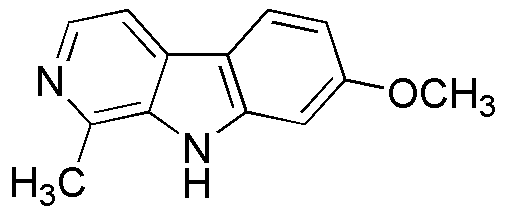Harmine is widely utilized in research focused on:
- Neuroscience: Harmine has shown potential in neuroprotective studies, aiding in the understanding of neurodegenerative diseases like Alzheimer's and Parkinson's. Researchers explore its ability to promote neuronal health and function.
- Pharmacology: This compound is investigated for its psychoactive properties, particularly in the context of mental health treatments. Its role as a monoamine oxidase inhibitor (MAOI) makes it a candidate for developing therapies for depression and anxiety.
- Traditional Medicine: Harmine is a key component in various herbal remedies, particularly in South American indigenous practices. Its applications in holistic healing and spiritual rituals are of interest to ethnobotanists and alternative medicine practitioners.
- Cancer Research: Studies are exploring harmine's potential anti-cancer properties. It has been observed to inhibit the growth of certain cancer cell lines, making it a subject of interest for developing new cancer therapies.
- Biotechnology: In the field of synthetic biology, harmine is being examined for its role in gene expression modulation. This application could lead to advancements in genetic engineering and biotechnology innovations.
Informations générales
Propriétés
Sécurité et réglementation
Applications
Harmine is widely utilized in research focused on:
- Neuroscience: Harmine has shown potential in neuroprotective studies, aiding in the understanding of neurodegenerative diseases like Alzheimer's and Parkinson's. Researchers explore its ability to promote neuronal health and function.
- Pharmacology: This compound is investigated for its psychoactive properties, particularly in the context of mental health treatments. Its role as a monoamine oxidase inhibitor (MAOI) makes it a candidate for developing therapies for depression and anxiety.
- Traditional Medicine: Harmine is a key component in various herbal remedies, particularly in South American indigenous practices. Its applications in holistic healing and spiritual rituals are of interest to ethnobotanists and alternative medicine practitioners.
- Cancer Research: Studies are exploring harmine's potential anti-cancer properties. It has been observed to inhibit the growth of certain cancer cell lines, making it a subject of interest for developing new cancer therapies.
- Biotechnology: In the field of synthetic biology, harmine is being examined for its role in gene expression modulation. This application could lead to advancements in genetic engineering and biotechnology innovations.
Documents
Fiches de données de sécurité (FDS)
La FDS fournit des informations de sécurité complètes sur la manipulation, le stockage et l’élimination du produit.
Spécifications du produit (PS)
Le PS fournit une description complète des propriétés du produit, notamment sa composition chimique, son état physique, sa pureté et les exigences de stockage. Il détaille également les plages de qualité acceptables et les applications prévues du produit.
Certificats d'analyse (COA)
Recherchez des certificats d'analyse (COA) en saisissant le numéro de lot du produit. Les numéros de lot et de lot se trouvent sur l'étiquette d'un produit, après les mots « Lot » ou « Lot de fabrication ».
Numéro de catalogue
Numéro de lot/série
Certificats d'origine (COO)
Ce certificat d'exploitation confirme le pays dans lequel le produit a été fabriqué, et détaille également les matériaux et composants utilisés et s'il est issu de sources naturelles, synthétiques ou autres sources spécifiques. Ce certificat peut être requis pour les douanes, le commerce et la conformité réglementaire.
Numéro de catalogue
Numéro de lot/série
Fiches de données de sécurité (FDS)
La FDS fournit des informations de sécurité complètes sur la manipulation, le stockage et l’élimination du produit.
DownloadSpécifications du produit (PS)
Le PS fournit une description complète des propriétés du produit, notamment sa composition chimique, son état physique, sa pureté et les exigences de stockage. Il détaille également les plages de qualité acceptables et les applications prévues du produit.
DownloadCertificats d'analyse (COA)
Recherchez des certificats d'analyse (COA) en saisissant le numéro de lot du produit. Les numéros de lot et de lot se trouvent sur l'étiquette d'un produit, après les mots « Lot » ou « Lot de fabrication ».
Numéro de catalogue
Numéro de lot/série
Certificats d'origine (COO)
Ce certificat d'exploitation confirme le pays dans lequel le produit a été fabriqué, et détaille également les matériaux et composants utilisés et s'il est issu de sources naturelles, synthétiques ou autres sources spécifiques. Ce certificat peut être requis pour les douanes, le commerce et la conformité réglementaire.

